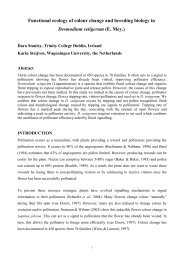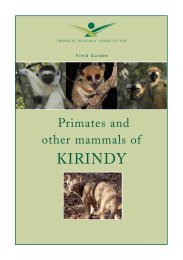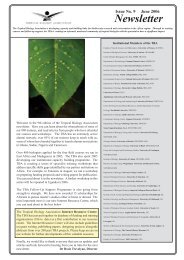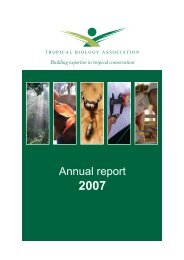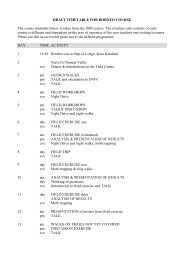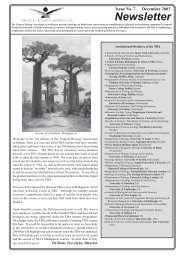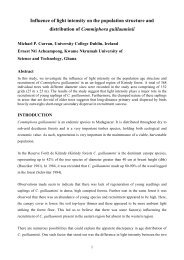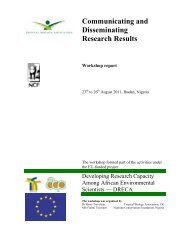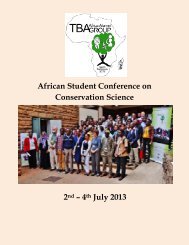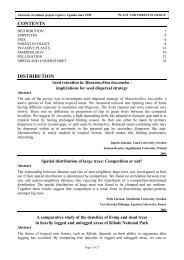Download TAAG Book of Abstracts - Tropical Biology Association
Download TAAG Book of Abstracts - Tropical Biology Association
Download TAAG Book of Abstracts - Tropical Biology Association
You also want an ePaper? Increase the reach of your titles
YUMPU automatically turns print PDFs into web optimized ePapers that Google loves.
The Role <strong>of</strong> ‘Dryland Wetlands’ in Semi AridMikuyuni<br />
River Catchment in South Eastern Kenya as sources <strong>of</strong><br />
livelihood<br />
Romulus Abila * 1 , Margaret Awuor Owuor 1 and Cecilia<br />
M. Musyoka 2 Agatha Nthenge 3<br />
1 School <strong>of</strong> Water Resources Science and Technology.<br />
South Eastern Kenya University Kenya.<br />
2 Department <strong>of</strong> Mathematics and Actuarial<br />
Science.South Eastern Kenya University, Kenya.<br />
3 Department <strong>of</strong> Environmental Science, Chuka<br />
University, Kenya<br />
*Email for correspondence: romulus.abila@seku.ac.ke,<br />
abilaowino@gmail.com,<br />
Abstract<br />
Communities in Kenya’s arid and semi arid lands (ASALs)<br />
experience high levels <strong>of</strong> poverty due to limited<br />
livelihood opportunities. ‘Dryland wetlands’ have been<br />
recognized as possible sources <strong>of</strong> livelihood<br />
opportunities yet without awareness and conservation<br />
measures, unsustainable exploitation <strong>of</strong> such wetlands<br />
could further contribute to their degradation. We<br />
analysed the role Mikuyuini ‘dryland wetland’ in south<br />
eastern Kenya as a source <strong>of</strong> livelihood by administering<br />
semi structured questionnaires to sixty wetland<br />
residents. The following 9 main direct economic gains<br />
from the wetland were identified: vegetable growing,<br />
bee keeping, fishing in the ‘dams’ during rainy season,<br />
sand harvesting, source <strong>of</strong> water for domestic and<br />
livestock, grazing land, brick making, source <strong>of</strong> building<br />
stone, source <strong>of</strong> trees for charcoal burning, and source<br />
<strong>of</strong> grass for thatching. There are different perceptions<br />
on who ‘owns’ the wetland. There is a high degree <strong>of</strong><br />
awareness by the community on economic activities<br />
that are detrimental to the ecological integrity <strong>of</strong> the<br />
wetlands. The following 5 activities were identified as<br />
detrimental: grazing, sand harvesting, tree cutting for<br />
charcoal, stone breaking and poor farming methods<br />
along the rivers. Conflicts among members <strong>of</strong> the<br />
community and between members <strong>of</strong> the<br />
community and two main church based organizations<br />
operation within the locality as well as government law<br />
enforcement agencies <strong>of</strong>ten arise concerning access to<br />
and exploitation <strong>of</strong> some <strong>of</strong> the resources. The following<br />
alternative livelihood activities were identified as<br />
environmentally sustainable and should be promoted:<br />
Tree nursery, vegetable growing in greenhouses, bee<br />
keeping, fish farming, and construction <strong>of</strong> terraces.<br />
Awareness creation on the importance <strong>of</strong> these dryland<br />
wetlands, a multi stakeholder participatory process to<br />
form a local water resource users association (WRUA)<br />
and implement a ‘sub catchment’ management plan are<br />
necessary to safeguard the wetland and minimize future<br />
conflicts.<br />
Wildlife Conservation Challenges in Okomu National<br />
Park, Nigeria<br />
*Olaleru, F. and Egonmwan, R.I.<br />
Natural Resources Conservation Unit, Department <strong>of</strong><br />
Zoology, University <strong>of</strong> Lagos, Nigeria<br />
*Email for correspondence: olalerufat@yahoo.com;<br />
folaleru@unilag.edu.ng<br />
Abstract<br />
Okomu National Park, Nigeria became one in 1999. It is<br />
a rainforest ecosystem that was gazetted from the<br />
former Okomu Forest Reserve. The Park is known for its<br />
endemic white-throated monkey (Cercopithecus<br />
erythrogaster) and rare red-capped mangabey<br />
(Cercocebus torquatus) and a host <strong>of</strong> other forest<br />
mammals, some <strong>of</strong> which are endangered. Since its<br />
inception the area has been encroached for reasons that<br />
need to be studied. This study looked at the challenges<br />
<strong>of</strong> conserving the Park’s wildlife and other resources. A<br />
Likert scale questionnaire was used to obtain primary<br />
data, while the Park’s record <strong>of</strong> arrests and prosecution<br />
from 1999 to 2011 was used as secondary data.<br />
Descriptive statistics were used to analyse the result.<br />
Eighty eight people responded to the questionnaire.<br />
84.4% agreed that wildlife are nature’s gift to man.<br />
62.2% and 91.1% agreed that people hunted for<br />
subsistence and commercial reasons respectively. Wild<br />
animals could only be conserved if their habitats were<br />
protected was the agreement <strong>of</strong> 84% respondents.<br />
Poor maintenance and management <strong>of</strong> protected areas<br />
could lead to loss <strong>of</strong> wildlife was the opinion <strong>of</strong> 91.1% <strong>of</strong><br />
the respondents. There were a total <strong>of</strong> 244 arrests<br />
during the period. The highest encroachment (15%) was<br />
in the first year, with farming taking the lead (67%).<br />
Hunting (poaching) and farming were the most common<br />
<strong>of</strong>fences (29% each), followed by logging (19%), entry<br />
(8%) and collection <strong>of</strong> non timber forest products (7%).<br />
The most disturbed areas were those compartments<br />
around the Park edges. Park staff could be more<br />
committed to protecting the resources when they are<br />
catered for appropriately. Creation <strong>of</strong> buffer zone could<br />
reduce Park’s encroachment rate.<br />
Keywords: Wildlife, Encroachment, Conservation<br />
Keywords: ‘Dryland wetland’, Mikuyuni, arid and semi<br />
arid lands (ASALs), Livelihood, participatory process.<br />
<strong>TAAG</strong> First African Student’s Conference, Nairobi. 2-4 July, 2013 31




